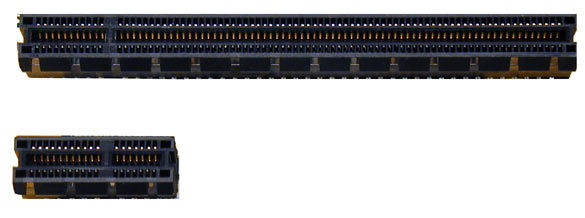Future Promise for Graphics: PCI Express
PCI Express - Possibilities, Possibilities, Continued
At IDF, Intel announced it was under contract (with parties not further specified) to offer desktop motherboards featuring one x16 slot connected to the Northbridge and four x1 slots connected to the Southbridge when PCI Express is introduced. The x8 and x12 slots will only be featured on server boards. Additionally, these boards will also feature a few classical PCI slots as well.
PCI Express slots differ in length, depending on the number of lanes they use. This seems to imply that they can be told apart quiet easily, but far from it. For example, it would be possible to attach two x16 slots to the Northbridge. If both slots are used, the bandwidth of each slot is reduced to x8, which is still equivalent to AGP 8x. On the other hand, it may be possible to circumvent such problems by using the IMC switch mentioned above. From an engineering perspective, it's even possible to create boards featuring both AGP and PCI Express slots by using a bridge chip. Whether or not any manufacturer is going to be brave enough to offer such a solution remains to be seen, though.
At any rate, the fact that the x16 slot will be connected via the Northbridge seems to point to limited performance. Despite the fact that PCI Express is designed with scalability in mind thanks to its nature as a serial bus, there are still limitations where the motherboards' chipsets are concerned, since the flood of data still has to be managed, i.e. read and written. Even the new DDR2 DRAM memory running at 500 MHz could quickly hit a wall.
Lastly, let me correct a wrong assumption some people have made. The notch at the front of the x16 cards may lead the casual observer to think the card will also work in an x1 slot - but this is not the case. It simply wouldn't fit. Besides, the slot wouldn't be able to provide enough current. Conversely, however, it would be possible to run an x1 card in an x16 or x8 slot.
The fastest and the slowest: x16 PCI Express (top) and x1.
The PCI Express specification calls for 25W for x1 slots, although most x1 devices only require around 10W. Further, PCI Express specifies 10W for x1 devices, 25W for x1 - x8 slots, and 75W for x16 slots, with another 75W for PCI Express the supplementary cable.
Right now, it's almost impossible to predict what all this means for every notebook owner's dream of external PCI Express graphics card.
Get Tom's Hardware's best news and in-depth reviews, straight to your inbox.
Current page: PCI Express - Possibilities, Possibilities, Continued
Prev Page PCI Express - Possibilities, Possibilities Next Page Conclusion
